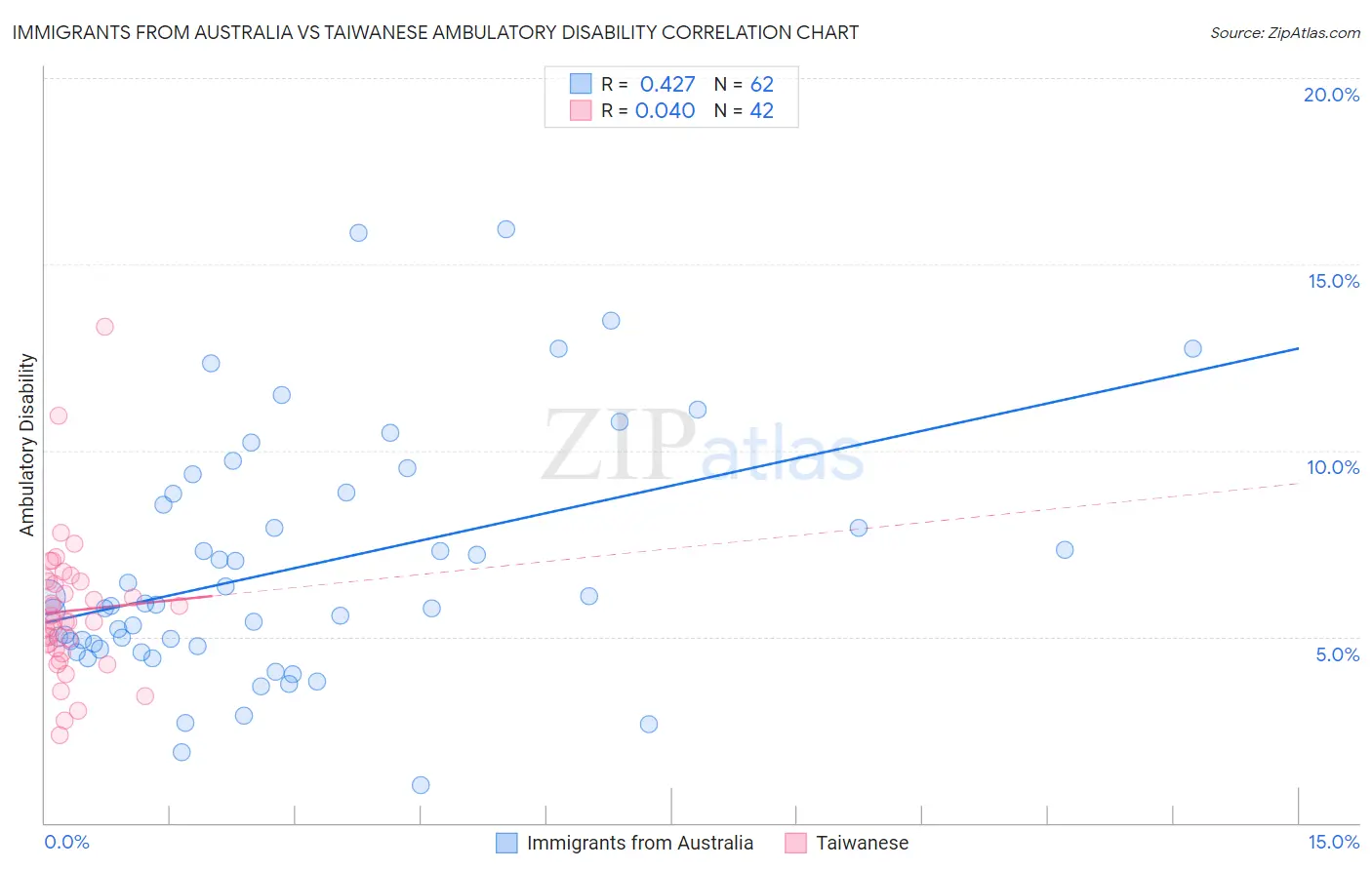Immigrants from Australia vs Taiwanese Ambulatory Disability
COMPARE
Immigrants from Australia
Taiwanese
Ambulatory Disability
Ambulatory Disability Comparison
Immigrants from Australia
Taiwanese
5.5%
AMBULATORY DISABILITY
100.0/ 100
METRIC RATING
32nd/ 347
METRIC RANK
5.6%
AMBULATORY DISABILITY
99.8/ 100
METRIC RATING
51st/ 347
METRIC RANK
Immigrants from Australia vs Taiwanese Ambulatory Disability Correlation Chart
The statistical analysis conducted on geographies consisting of 227,168,976 people shows a moderate positive correlation between the proportion of Immigrants from Australia and percentage of population with ambulatory disability in the United States with a correlation coefficient (R) of 0.427 and weighted average of 5.5%. Similarly, the statistical analysis conducted on geographies consisting of 31,722,995 people shows no correlation between the proportion of Taiwanese and percentage of population with ambulatory disability in the United States with a correlation coefficient (R) of 0.040 and weighted average of 5.6%, a difference of 2.5%.

Ambulatory Disability Correlation Summary
| Measurement | Immigrants from Australia | Taiwanese |
| Minimum | 1.0% | 2.4% |
| Maximum | 15.9% | 13.3% |
| Range | 14.9% | 11.0% |
| Mean | 6.8% | 5.7% |
| Median | 5.8% | 5.4% |
| Interquartile 25% (IQ1) | 4.7% | 4.7% |
| Interquartile 75% (IQ3) | 8.9% | 6.5% |
| Interquartile Range (IQR) | 4.1% | 1.8% |
| Standard Deviation (Sample) | 3.3% | 1.9% |
| Standard Deviation (Population) | 3.2% | 1.9% |
Demographics Similar to Immigrants from Australia and Taiwanese by Ambulatory Disability
In terms of ambulatory disability, the demographic groups most similar to Immigrants from Australia are Immigrants from Pakistan (5.5%, a difference of 0.12%), Immigrants from Venezuela (5.4%, a difference of 0.17%), Immigrants from Asia (5.5%, a difference of 0.28%), Afghan (5.5%, a difference of 0.32%), and Immigrants from Malaysia (5.5%, a difference of 0.39%). Similarly, the demographic groups most similar to Taiwanese are Luxembourger (5.6%, a difference of 0.10%), Bulgarian (5.6%, a difference of 0.44%), Immigrants from Argentina (5.6%, a difference of 0.64%), Egyptian (5.6%, a difference of 0.65%), and Immigrants from Japan (5.6%, a difference of 0.65%).
| Demographics | Rating | Rank | Ambulatory Disability |
| Immigrants | Venezuela | 100.0 /100 | #31 | Exceptional 5.4% |
| Immigrants | Australia | 100.0 /100 | #32 | Exceptional 5.5% |
| Immigrants | Pakistan | 100.0 /100 | #33 | Exceptional 5.5% |
| Immigrants | Asia | 100.0 /100 | #34 | Exceptional 5.5% |
| Afghans | 100.0 /100 | #35 | Exceptional 5.5% |
| Immigrants | Malaysia | 100.0 /100 | #36 | Exceptional 5.5% |
| Turks | 100.0 /100 | #37 | Exceptional 5.5% |
| Cypriots | 100.0 /100 | #38 | Exceptional 5.5% |
| Immigrants | Eritrea | 100.0 /100 | #39 | Exceptional 5.5% |
| Venezuelans | 99.9 /100 | #40 | Exceptional 5.5% |
| Mongolians | 99.9 /100 | #41 | Exceptional 5.5% |
| Argentineans | 99.9 /100 | #42 | Exceptional 5.5% |
| Paraguayans | 99.9 /100 | #43 | Exceptional 5.5% |
| Immigrants | Indonesia | 99.9 /100 | #44 | Exceptional 5.5% |
| Immigrants | Sweden | 99.9 /100 | #45 | Exceptional 5.6% |
| Egyptians | 99.9 /100 | #46 | Exceptional 5.6% |
| Immigrants | Japan | 99.9 /100 | #47 | Exceptional 5.6% |
| Immigrants | Argentina | 99.9 /100 | #48 | Exceptional 5.6% |
| Bulgarians | 99.9 /100 | #49 | Exceptional 5.6% |
| Luxembourgers | 99.9 /100 | #50 | Exceptional 5.6% |
| Taiwanese | 99.8 /100 | #51 | Exceptional 5.6% |